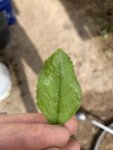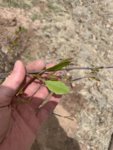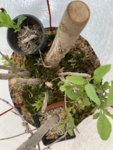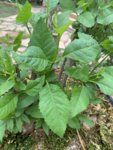You are using an out of date browser. It may not display this or other websites correctly.
You should upgrade or use an alternative browser.
You should upgrade or use an alternative browser.
Tree Id HELP
- Thread starter Hartinez
- Start date
Bonsai Nut
Nuttier than your average Nut
Can you show the leaves on the stem?
Hartinez
Masterpiece
PiñonJ
Omono
Hartinez
Masterpiece
Oh int
Interesting! It was the only one of its kind I found. It had such a lovely clump form and I figured would be a perfect, natural made forest if chopped and cultivated properly. I dug it up over 3 weeks ago and after about 9 or so days of in-action with obvious life still in the tree, I decided to bag it to sweat out buds. It started budding almost immediately! I’ll get a better photo, once I take the bag off.River Hawthorn?
View attachment 242546
Hartinez
Masterpiece
Hartinez
Masterpiece
PiñonJ
Omono
I don’t think so, based on distribution, if nothing else. My source says it starts at 7000’, yours says 6500’. Either way, it’s higher than where you were. The description and illustration for River Hawthorn still matches more closely what you’ve shown, so far. Time will tell.I think my buddy figured it out for me.
Thinleaf alder. Alnus Incana subspecies

Hartinez
Masterpiece
Go
Good point on the elevation. He also thought it could be water birch, but the bark doesn’t matchup. I’m just not seeing thorns yet or the zig zagging growth of hawthorn.I don’t think so, based on distribution, if nothing else. My source says it starts at 7000’, yours says 6500’. Either way, it’s higher than where you were. The description and illustration for River Hawthorn still matches more closely what you’ve shown, so far. Time will tell.
View attachment 243327
Hartinez
Masterpiece
It’s growing pretty
great at this point, but I’m out of town in Estes park for a week, then San Diego for a week. My friend is watering my trees at home which has me anxious and wondering what the growth is looking like on this tree! Needless to say, when I’m back home I’ll be able to have a better idea of what it is.I don’t think so, based on distribution, if nothing else. My source says it starts at 7000’, yours says 6500’. Either way, it’s higher than where you were. The description and illustration for River Hawthorn still matches more closely what you’ve shown, so far. Time will tell.
View attachment 243327
Leo in N E Illinois
The Professor
- Messages
- 11,338
- Reaction score
- 23,275
- USDA Zone
- 5b
In the photos, the leaves looked like an opposite arrangement? Most of the names offered were trees with alternate leaf patterns?
Or were my eye deceiving me? Opposite leaves would point to groups like Cornus - dogwood family, or Olive family (desert privet, etc) or ?
Alternate leaves and indeed hawthorn might be a guess.
The 3 veins in the leaf that were slightly more prominent made me think of one of the shrubby species of Hackberry. Celtis. Not the C. occidentalis or C. laevigata but one of the western desert shrub forms. But I am just guessing.
Or were my eye deceiving me? Opposite leaves would point to groups like Cornus - dogwood family, or Olive family (desert privet, etc) or ?
Alternate leaves and indeed hawthorn might be a guess.
The 3 veins in the leaf that were slightly more prominent made me think of one of the shrubby species of Hackberry. Celtis. Not the C. occidentalis or C. laevigata but one of the western desert shrub forms. But I am just guessing.
Hartinez
Masterpiece
That’s why I posted! All guesses, but in this case, intelligent guess, are more than welcome. I’ll look in to your suggestions!
In the photos, the leaves looked like an opposite arrangement? Most of the names offered were trees with alternate leaf patterns?
Or were my eye deceiving me? Opposite leaves would point to groups like Cornus - dogwood family, or Olive family (desert privet, etc) or ?
Alternate leaves and indeed hawthorn might be a guess.
The 3 veins in the leaf that were slightly more prominent made me think of one of the shrubby species of Hackberry. Celtis. Not the C. occidentalis or C. laevigata but one of the western desert shrub forms. But I am just guessing.
Hartinez
Masterpiece
Leo in N E Illinois
The Professor
- Messages
- 11,338
- Reaction score
- 23,275
- USDA Zone
- 5b
Your tree in question clearly has OPPOSITE leaves. Whether a tree or shrub has opposite or alternate leaves is a fundamental or base trait, tends to be consistent in whole families of trees. For example ALL maples, genus Acer have opposite leaves. All elms have alternate leaves. This is a very basic way to separate groups of trees.
All member of the Birch genus, Betula, have ALTERNATE leaves, so Birch is OUT.
Alders are members of the genus Alnus - all have ALTERNATE leaves, so Alder is OUT.
look up - Jamesia americana - Cliff Bush - it is in the Hydrangea family - note it has opposite leaves and is a shrub. I found it while browsing through links I listed below.
I believe this will help you find your plant - specific for New Mexico
https://nmfwri.org/restoration-information/plant-guides
If you have trouble using identification keys, here is a primer.
http://identifythatplant.com/plant-id-resources/plant-id-websites/
https://msb.unm.edu/divisions/herbarium/resources/index.html
https://aces.nmsu.edu/pubs/_circulars/CR374_SM.pdf
https://www.nmenvirothon.org/application/files/9415/1347/2903/Ch.1_NM_trees.pdf
https://peecnature.org/learn/nature-guides/tree-guide/
https://plantsofthesouthwest.com/collections/trees-shrubs
https://www.fs.fed.us/wildflowers/features/books/swbooks.shtml
https://www.inaturalist.org/guides/2071
https://sweri.eri.nau.edu/
https://nmfwri.org/restoration-information/plant-guides
this link below is the Vascular plants of the Gila Wilderness, looks exhaustive - as in it has them ALL.
https://wnmu.edu/academic/nspages/gilaflora/index.html
https://wnmu.edu/academic/nspages/gilaflora/eudicots.html - table with families, I went through a few - this is a good resource if you already have a good idea what you are looking for.
I might have found it, look at:
Jamesia americana - Cliffbush - it is in the Hydrangea family.
All member of the Birch genus, Betula, have ALTERNATE leaves, so Birch is OUT.
Alders are members of the genus Alnus - all have ALTERNATE leaves, so Alder is OUT.
look up - Jamesia americana - Cliff Bush - it is in the Hydrangea family - note it has opposite leaves and is a shrub. I found it while browsing through links I listed below.
I believe this will help you find your plant - specific for New Mexico
https://nmfwri.org/restoration-information/plant-guides
If you have trouble using identification keys, here is a primer.
http://identifythatplant.com/plant-id-resources/plant-id-websites/
https://msb.unm.edu/divisions/herbarium/resources/index.html
https://aces.nmsu.edu/pubs/_circulars/CR374_SM.pdf
https://www.nmenvirothon.org/application/files/9415/1347/2903/Ch.1_NM_trees.pdf
https://peecnature.org/learn/nature-guides/tree-guide/
https://plantsofthesouthwest.com/collections/trees-shrubs
https://www.fs.fed.us/wildflowers/features/books/swbooks.shtml
https://www.inaturalist.org/guides/2071
https://sweri.eri.nau.edu/
https://nmfwri.org/restoration-information/plant-guides
this link below is the Vascular plants of the Gila Wilderness, looks exhaustive - as in it has them ALL.
https://wnmu.edu/academic/nspages/gilaflora/index.html
https://wnmu.edu/academic/nspages/gilaflora/eudicots.html - table with families, I went through a few - this is a good resource if you already have a good idea what you are looking for.
I might have found it, look at:
Jamesia americana - Cliffbush - it is in the Hydrangea family.
Hartinez
Masterpiece
Man. Leo, I’m sorry I overlooked your opposing leaves comment, but your absolutely right, alder and birch are out. And i also don’t think it is a cliff bush. The bark and new growth doesn’t match the images I’m seeing, plus the largest of the trunks on this one is at least 3” and it seems pretty clear this is a small version of a much larger tree. This was dug in the Bosque along the Rio grande in Albuquerque, not quite Gila Wilderness range. Your efforts and help are not unrecognized and I can’t thank you enough though!! The search continues!!Your tree in question clearly has OPPOSITE leaves. Whether a tree or shrub has opposite or alternate leaves is a fundamental or base trait, tends to be consistent in whole families of trees. For example ALL maples, genus Acer have opposite leaves. All elms have alternate leaves. This is a very basic way to separate groups of trees.
All member of the Birch genus, Betula, have ALTERNATE leaves, so Birch is OUT.
Alders are members of the genus Alnus - all have ALTERNATE leaves, so Alder is OUT.
look up - Jamesia americana - Cliff Bush - it is in the Hydrangea family - note it has opposite leaves and is a shrub. I found it while browsing through links I listed below.
I believe this will help you find your plant - specific for New Mexico
https://nmfwri.org/restoration-information/plant-guides
If you have trouble using identification keys, here is a primer.
http://identifythatplant.com/plant-id-resources/plant-id-websites/
https://msb.unm.edu/divisions/herbarium/resources/index.html
https://aces.nmsu.edu/pubs/_circulars/CR374_SM.pdf
https://www.nmenvirothon.org/application/files/9415/1347/2903/Ch.1_NM_trees.pdf
https://peecnature.org/learn/nature-guides/tree-guide/
https://plantsofthesouthwest.com/collections/trees-shrubs
https://www.fs.fed.us/wildflowers/features/books/swbooks.shtml
https://www.inaturalist.org/guides/2071
https://sweri.eri.nau.edu/
https://nmfwri.org/restoration-information/plant-guides
this link below is the Vascular plants of the Gila Wilderness, looks exhaustive - as in it has them ALL.
https://wnmu.edu/academic/nspages/gilaflora/index.html
https://wnmu.edu/academic/nspages/gilaflora/eudicots.html - table with families, I went through a few - this is a good resource if you already have a good idea what you are looking for.
I might have found it, look at:
Jamesia americana - Cliffbush - it is in the Hydrangea family.
Hartinez
Masterpiece
Wadewebb2014
Seed
- Messages
- 2
- Reaction score
- 0
Leo in N E Illinois
The Professor
- Messages
- 11,338
- Reaction score
- 23,275
- USDA Zone
- 5b
No problem,
I am guilty of just skimming over posts myself. Easy enough to miss.
I bet your answer is in one of the links I posted last night. One of them was specific to the Bosque region. So as time permits, you should explore those resources. And if you are serious about collecting locally native trees, pick up one of the reference books mentioned.
@Wadewebb2014 - Nice color pattern in the leaves. As you can see from the previous example, how the leaves join the branch is critical in making an identification. Your photo at best shows just the general shape of the leaves.
However, I can make a guess. You should look up Polyscias, it is in the Aralia family. I bet is you have one of the Polyscias species, and a nice cultivar of one at that.
Hit the books, I am out of time for today.
I am guilty of just skimming over posts myself. Easy enough to miss.
I bet your answer is in one of the links I posted last night. One of them was specific to the Bosque region. So as time permits, you should explore those resources. And if you are serious about collecting locally native trees, pick up one of the reference books mentioned.
@Wadewebb2014 - Nice color pattern in the leaves. As you can see from the previous example, how the leaves join the branch is critical in making an identification. Your photo at best shows just the general shape of the leaves.
However, I can make a guess. You should look up Polyscias, it is in the Aralia family. I bet is you have one of the Polyscias species, and a nice cultivar of one at that.
Hit the books, I am out of time for today.
Wadewebb2014
Seed
- Messages
- 2
- Reaction score
- 0
No problem,
I am guilty of just skimming over posts myself. Easy enough to miss.
I bet your answer is in one of the links I posted last night. One of them was specific to the Bosque region. So as time permits, you should explore those resources. And if you are serious about collecting locally native trees, pick up one of the reference books mentioned.
@Wadewebb2014 - Nice color pattern in the leaves. As you can see from the previous example, how the leaves join the branch is critical in making an identification. Your photo at best shows just the general shape of the leaves.
However, I can make a guess. You should look up Polyscias, it is in the Aralia family. I bet is you have one of the Polyscias species, and a nice cultivar of one at that.
Hit the books, I am out of time for today.
Thank you so much I have been looking for how to care for it . And now that I have the name I'll look through these threads l. Again thank you so much.
PiñonJ
Omono
Similar threads
- Replies
- 7
- Views
- 456
- Replies
- 4
- Views
- 275













